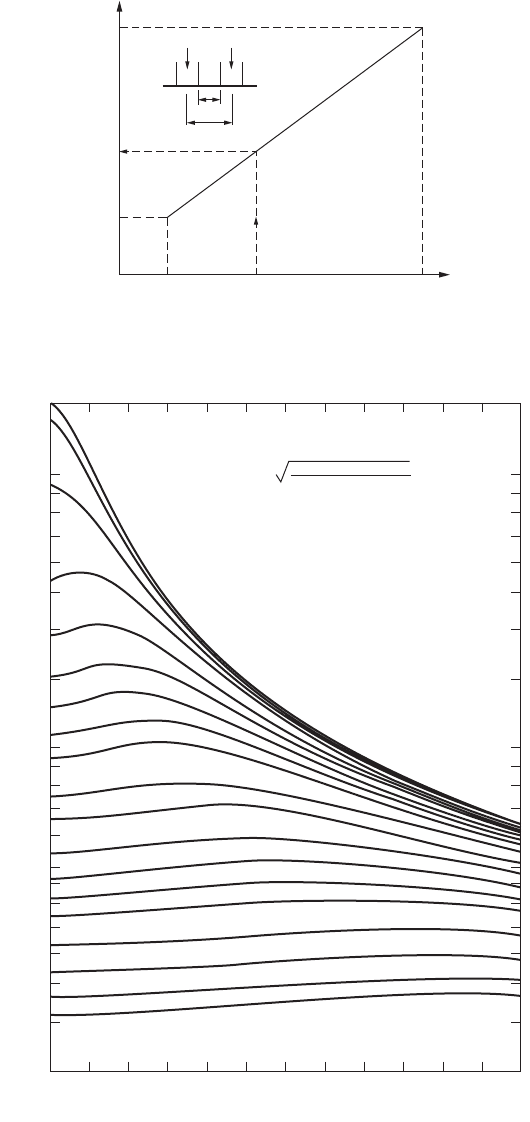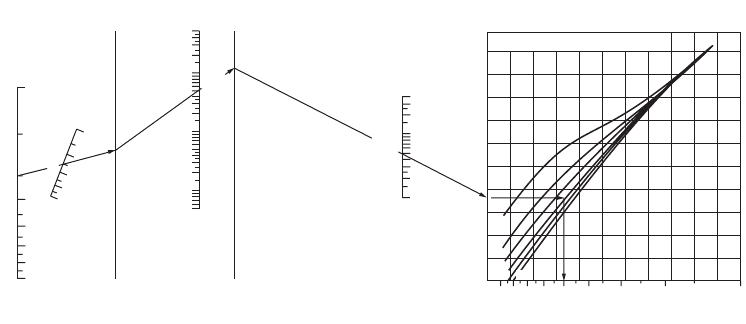Wai-Fah Chen.The Civil Engineering Handbook
Подождите немного. Документ загружается.


62-20 The Civil Engineering Handbook, Second Edition
Example 62.5
This example concerns the representation of annual departures of designed aircraft. An airport pavement
is to be designed for the following estimated traffic:
In this example, the 727-200 requires the greatest pavement thickness and is therefore the design
aircraft. The conversion factors are obtained from Table 62.9. The entries in the last column are the
products of the conversion factors and the estimated annual departures.
Equal Stress ESWL
An elaborate procedure for computing the ESWL would call for both a proper analytical solution for the
required stress produced by the wheel assembly of interest and a trial-and-error process to identify the
magnitude of the single wheel that will produce identical stress. As this procedure is time consuming,
simplified methods have been employed in practice.
Figure 62.5(a) presents a simplified procedure for estimating the equal subgrade stress ESWL of a set
of dual wheels for flexible pavement design. With the assumed 45˚ spread of applied pressure, the ESWL
is equal to one wheel load P if the pavement thickness is less than or equal to d/2, where d is the smallest
edge-to-edge distance between the tire imprints of the dual wheels. The method further assumes that
ESWL = 2P for any pavement equal to or thicker than 2S, where S is the center-to-center spacing of the
dual wheels. For pavement thicknesses between d/2 and 2S, ESWL is determined, as shown in Fig. 62.5(a),
by assuming a linear log–log relationship between ESWL and pavement thickness. Note that d is equal
to (S – 2a), where a is the radius of tire imprint given by
(62.3)
where p is the tire pressure.
This simplified procedure provides an approximate ESWL estimation for flexible pavements. In the
case of rigid pavements, computation of stresses for equal stress ESWL should be based on rigid slab
analysis such as the well-known Westergaard formulas, which give the maximum bending stress s
max
and
the maximum deflection d
max
as shown below. s
max
and d
max
under interior loading [Westergaard, 1926]
are given as
(62.4)
(62.5)
where b = (1.6a
2
+ h
2
)
0.5
– 0.675h, a < 1.724h
= a, a > 1.724h
P =total applied load
m = slab Poisson’s ratio
Aircraft
Landing
Gear Type
Est. Annual
Departures
Max. Wt.
(kips)
Conversion
Factor
Converted Annual
Departures
727-100 Dual 4500 160 1.0 4500
727-200 Dual 9900 190.5 1.0 9900
707-320B Dual tandem 3200 327 1.7 5440
DC-9-30 Dual 5500 108 1.0 5500
747-100 Dual DT 60 700 1.7 102
a
P
p
p
------=
s
max
3P 1
m
+()
2
p
h
2
------------------------
2L
b
------
˯
ʈ
ln 0.5
g
–+
3P 1
m
+()
64h
2
------------------------
b
L
---
˯
ʈ
2
+=
d
max
P
8kL
2
-----------
1
a
2
2
p
L
2
------------
a
2L
------
˯
ʈ
ln
g
1.25–+
+
Ó ˛
Ì ˝
ϸ
=

Highway and Airport Pavement Design 62-21
(b)
FIGURE 62.5 Computation of ESWL. (a) Equal subgrade stress ESWL of dual wheels for flexible pavement design.
(b) One-layer deflection factor for equal-deflection ESWL computation. (Source: Yo der, E.J. and Witczak, M.W.,
Principles of Pavement Design, 2nd ed., John Wiley & Sons, New York, 1975, p. 138. With permission.)
d/2 z 2S
P
2P
PP
d
s
z = depth of pavement
structure
Log (Depth below pavement surface)
(ESWL)
Log (Load)
(a)
0123456789101112
1.5
1.0
0.9
0.8
0.7
0.6
0.5
0.4
0.3
0.2
0.18
0.16
0.14
0.12
0.10
0.09
0.08
0.07
0.06
0.05
0.04
0.03
0.5
1.0
1.5
2.0
2.5
3.0
3.5
4.0
5.0
6.0
7.0
8.0
9.0
10.0
12.0
14.0
16.0
17.5
0.0
Offset radii
Radii =
Single-tire contact area
p
Depth (radii)
Deflection factor

62-22 The Civil Engineering Handbook, Second Edition
h = slab thickness
L = radius of relative stiffness
a =radius of loaded area
k =modulus of subgrade reaction
g =Euler’s constant = 0.577216
s
max
and d
max
under edge loading [Westergaard, 1926, 1933, 1948] are given as
(62.6)
(62.7)
where E = slab
elastic modulus and all other variables are as defined in Eqs. (62.1) and (62.2). s
max
and
d
max
under corner loading [Westergaard 1926] are given as
(62.8)
(62.9)
Example 62.6
This example addresses equal subgrade stress ESWL. The total load on a set of dual wheels is 45,000 lb.
The tire pressure of the wheels is 185 psi. The center-to-center spacing of the wheels is 34 in. Calculate
the equal stress ESWL if the thickness of pavement structure is (a) h = 30 in. and (b) h = 70 in.
Load per wheel = 22,500 lb., radius of tire imprint a = = 6.22 in., S = 34 in., and d =
(S – 2a) = 21.56. By means of a log–log plot as shown in Fig. 62.5(a), ESWL is determined to be 33,070
lb. for h = 30 in. For h = 70 in., since h > 2S, ESWL = 2(22,500) = 45,000 in.
Equal Deflection ESWL
Equal deflection ESWL can be derived by assuming either constant tire pressure or constant area of tire
imprint. A simplified method for computing ESWL on flexible pavement, based on the Boussinesq one-
layer theory [Boussinesq, 1885], is presented in this section. It computes the ESWL of an assembly of n
wheels by equating the surface deflection under the ESWL to the maximum surface deflection caused by
the wheel assembly, that is,
(62.10)
where P =gross load on each tire of the wheel assembly
E =stiffness modulus of the soil
K, K
1
, K
2
, K
n
=Boussinesq deflection factor given by Fig. 62.5(b)
With the assumption of constant tire pressure, Eq. (62.2) can be solved for ESWL by the following
iterative procedure: (1) compute (K
1
+ K
2
+ L + K
n
)
max
at the point of maximum surface deflection;
(2) assume a, the radius of tire imprint for ESWL; (3) determine K from Fig. 62.5(b) with zero horizontal
s
max
31
m
+()P
p
3
m
+()h
2
--------------------------
Eh
3
100ka()
4
---------------------
ln 1.18
a
L
---
˯
ʈ
12
m
+()2.34
11
6
-----
m
–++
Ó ˛
Ì ˝
ϸ
=
d
max
P
21.2
m
+()
Eh
3
k
-------------------------
0.5
10.76 0.4
m
+()
a
L
---
˯
ʈ
–
Ó ˛
Ì ˝
ϸ
=
s
max
3P
h
2
------
1
1.4142a
L
-------------------
˯
ʈ
0.6
–
˯
ʈ
=
d
max
P
kL
2
--------
1.1 0.88
1.4142a
L
-------------------
˯
ʈ
–
˯
ʈ
=
22 500 /185
p
,()
ESWL()
0.5
p
E
--------------------------
K
P
0.5
p
E
--------
K
1
K
2
L K
n
+++()
max
=

Highway and Airport Pavement Design 62-23
offset; (4) compute ESWL from Eq. (62.2); (5) calculate new a = and (6) if new a does not
match the assumed a, return to step (3) and repeat the procedure with the new a until convergence.
Deflections of rigid pavements under loads are computed by means of Westergaard’s theory [see
Eqs. (62.4–62.9)] or more elaborate analysis using the finite-element method. Improved deflection com-
putations using thick-plate theory [Shi et al., 1994; Fwa et al., 1993] could also be used for the purpose
of ESWL evaluation.
Example 62.7
Calculate the equal subgrade-deflection ESWL for the dual wheels in Example 62.6 for h = 30 in. (h/a) =
4.82. For a point directly below one of the wheels, (r/a)
1
= (34/6.22) = 5.47, K
1
= 0.15 [from Fig. 62.5(b)];
and (r/a)
2
= 0, K
2
= 0.31. For the point on the vertical line midway between the two wheels, (r/a)
1
=
(r/a)
2
= 2.73, and K
1
= K
2
= 0.24 [from Fig. 62.5(b)]. The critical (K
1
+ K
2
) = 0.48. The ESWL is obtained
by trial and error as follows. The ESWL equals 35,950 lb.
Critical Areas for Pavement Design
Runway ends, taxiways, aprons, and turnoff ramp areas receive a concentration of aircraft movements
with maximum loads. They are designated as the critical areas for pavement design purposes. Reduced
thickness may be used for other areas.
62.5 Thickness Design of Flexible Pavements
The thickness design of flexible pavements is a complex engineering problem involving a large number
of variables. Most of the design methods in use today are largely empirical or semiempirical procedures
derived from either full-scale pavement tests or performance monitoring of in-service pavements. This
section presents the methods of the Asphalt Institute and AASHTO for flexible highway pavements and
the FAA method for flexible airport pavements. A brief description of the development of the mechanistic
approach to flexible pavement design is also presented.
AASHTO Design Procedure for Flexible Highway Pavements
The AASHTO design procedure [AASHTO, 1993] was developed based on the findings of the AASHO
road test [Highway Research Board, 1962]. It defines pavement performance in terms of the present
serviceability index (PSI), which varies from 0 to 5. The PSIs of newly constructed flexible pavements
and rigid pavements were found to be about 4.2 and 4.5, respectively. For pavements of major highways,
the end of service life is considered to be reached when PSI = 2.5. A terminal value of PSI = 2.0 may be
used for secondary roads. Serviceability loss, given by the difference of the initial and terminal service-
ability, is required as an input parameter. Pavement layer thicknesses are designed using the nomograph
in Fig. 62.6. The design traffic loading in ESAL is computed by Eq. (62.2). Other input parameters are
discussed in this section.
Reliability
The AASHTO guide incorporates in the design a reliability factor R% to account for uncertainties in
traffic prediction and pavement performance. R% indicates the probability that the pavement designed
will not reach the terminal serviceability level before the end of the design period. The AASHTO suggested
Tr ial a (h/a)KESWL by Eq. (62.10) New a by Eq. (62.3)
6.5 in. 4.615 0.3177 51,361 lb. 9.40
8.0 in. 3.75 0.3865 34,704 lb. 7.73
7.85 in. 3.8217 0.3797 35,954 lb. 7.86
P/
p
p();

62-24 The Civil Engineering Handbook, Second Edition
ranges of R% are 85 to 99.9%, 80 to 99%, 80 to 95%, and 50 to 80% for urban interstates, principal
arterials, collectors, and local roads, respectively. The corresponding ranges for rural roads are 80 to
99.9%, 75 to 95%, 75 to 95%, and 50 to 80%. The overall standard deviation, s
o
, for flexible and rigid
pavements developed at the AASHO road test is 0.45 and 0.35, respectively.
Effective Roadbed Soil Resilient Modulus
Determination of Subgrade Resilient Modulus. The total pavement thickness requirement is a function
of the resilient modulus, M
r
, of subgrade soil. Methods for the determination of M
r
for granular materials
and fine-grained soils are described in AASHTO Test Method T274 [AASHTO, 1989].
Since many laboratories are not equipped to perform the resilient modulus test for soils, it is common
practice to estimate M
r
through empirical correlation with other soil properties. Equation (62.11) is one
such correlation suggested by AASHTO for fine-grained soils with soaked CBR of 10 or less.
(62.11)
Other correlations are also found in the literature, such as in the work by Van Til et al. [1972].
Determination of Effective M
r
. To account for seasonal variations of subgrade soil resilient modulus,
AASHTO defines an effective roadbed soil M
r
to represent the combined effect of all the seasonal modulus
values. This effective M
r
is a weighted value that would give the correct equivalent annual pavement
damage for design purpose. The steps in computing the effective M
r
are as follows:
1. Divide the year into equal-length time intervals, each equal to the smallest season. AASHTO
suggests that the smallest season should not be less than one-half month.
2. Estimate the relative damage u
f
corresponding to each seasonal modulus by the following equation:
(62.12)
where M
r
is expressed in 10
3
psi.
3. Sum the u
f
of all seasons and divide by the number of seasons to give the average seasonal damage.
4. Substitute the average seasonal damage into Eq. (62.12) and calculate M
r
to arrive at the effective
roadbed soil M
r
.
FIGURE 62.6 AASHTO design chart for flexible highway pavements. (Source: AASHTO Guides for Design of Pave-
ment Structures, American Association of State Highway and Transportation Officials, Washington, D.C., 1993. With
permission.)
99.9
99
90
80
70
60
50
50
10
5.0
1.0
.5
.1
.05
40
20
10
5
1
Reliability, R(%)
Overall
Standard Deviation, S
0
.6
.4
.2
Estimated Total 18-kip Equivalent
Single Axle Load Applications, W
18
(millions)
Effective Roadbed Soil
Resilient Modulus, M
R
(ksi)
Design Structural Number, SN
987 6 5 4 3 2
1
Design Serviceability Loss, DPSI
.05
1.0
1.5
2.0
T
L
T
L
3.0
M
r
psi() 1500 CBR¥=
u
f
1.18 10
8
¥ M
r
2.32–
¥=

Highway and Airport Pavement Design 62-25
Example 62.8
This example examines effective roadbed soil resilient modulus. The resilient moduli of a roadbed soil
determined at 24 half-month intervals are 6000, 20,000, 20,000, 4000, 4500, 5000, 6000, 6000, 5000, 5000,
5000, 6000, 6000, 6500, 6500, 6500, 6500, 6500, 6000, 6000, 5500, 5500, 5500, and 6000. The total relative
damage u computed by Eq. (62.12) is
The mean u = 0.232. Applying Eq. (62.12) again, the effective M
r
is 5655 psi.
Pavement Layer Modulus
Structural thicknesses required above other pavement layers are also determined based on their respec-
tive M
r
values. For bituminous pavement layers, M
r
may be tested by the repeated load indirect tensile
test described in ASTM Test D-4123 [ASTM, 1992]. Figure 62.7 shows a chart developed by Van Til et al.
[1972] relating M
r
of hot-mix asphalt mixtures to other properties.
For unbound base and subbase materials, M
r
may be estimated from the following correlations:
(62.13)
FIGURE 62.7 Correlation charts for estimating resilient modulus of asphalt concrete. (Source: Van Til, C.J. et al.,
Evaluation of AASHO Interim Guides for Design of Pavement Structures, NCHRP Report 128, Highway Research Board,
Washington, D.C., 1972.)
0.6
0.5
0.4
0.3
0.2
1800
2000
1600
1400
1200
1000
800
600
400
400
300
200
175
150
125
100
1.0
1.5
2.0
2.5
3.0
4.0
4.5
5.0
6.0
7.0
8.0
9.0
10.0
Structural layer coefficient
Marshall Stability (1Ib)
Cohesiometer at 140∞
Modulus
(3)
10
5
-psi
Structural coefficient (a
2
)
Marshall stability (1Ib)
Modulus-10
5
psi
4.0
3.0
2.5
2.0
1.5
1.0
1900
0.40
0.30
0.20
0.10
1700
1500
1300
1100
900
700
500
300
200
100
(a) Surface Course (b) Base Course
u 0.2026 0.0124 0.0124 0.5189 0.3948 0.3092 0.2026++++++=
0.2026 0.3092 0.3092 0.3092 0.2026 0.2026 0.1682+++++++
0.1682 0.1682 0.1682 0.1682 0.2026 0.2026 0.2479+++++++
0.2479 0.2479 0.2026+++
5.568=
M
r
psi() 740 CBR for
q
¥ 100 psi==

62-26 The Civil Engineering Handbook, Second Edition
(62.14)
(62.15)
(62.16)
where q is the
sum of principal stresses, (s
1
+ s
2
+ s
3
).
Thickness Requirements
Using the input parameters described in the preceding sections, the total pavement thickness requirement
is obtained from the nomograph in Fig. 62.6 in terms of structural number SN. SN is an index number
equal to the weighted sum of pavement layer thicknesses, as follows:
(62.17)
where a
1
, a
2
, and a
3
are numbers known as layer coefficients; D
1
, D
2
, and D
3
are layer thicknesses; and
m
2
and m
3
are layer drainage coefficients. SN can be considered a form of equivalent thickness, and layer
coefficients and drainage coefficients are applied to actual pavement thicknesses to account for their
structural and drainage properties, respectively.
Drainage coefficients are determined from Table 62.10. Coefficient a
1
can be estimated from Fig. 62.8.
Coefficients a
2
and a
3
of granular base and subbase layers can be obtained from the following correlations:
(62.18)
(62.19)
where q is the stress state in psi, and k
1
and k
2
are regression constants. Recommended values
are given in Table 62.11.
The thicknesses of individual pavement layers are determined by means of the layer analysis concept
depicted in Fig. 62.9. The total structural number required above the subgrade soil, denoted SN
1
, is
TA BLE 62.10 Base and Subbase Stress States
Asphalt Concrete
Thickness (inches)
Roadbed Soil Resilient
Modulus (psi)
3000 7500 15,000
(a) Stress State for Base Course
Less than 2 201 25 30
2–4 10 15 20
4–6 5 10 15
Greater than 6 5 5 5
Asphalt Concrete
Thickness (inches) Stress State (psi)
(b) Stress State for Subbase (6–12 in.)
Less than 2 10.0
2–4 7.5
Greater than 4 5.0
Source: AASHTO Guide for Design of Pavement
Structures, American Association of State Highway and
Transportation Officials, Washington, D.C., 1993.
With permission.
M
r
psi() 440 CBR for
q
¥ 30 psi==
M
r
psi() 340 CBR for
q
¥ 20 psi==
M
r
psi() 250 CBR for
q
¥ 10 psi==
SN a
1
D
1
a
2
D
2
m
2
a
3
D
3
m
3
++=
a
2
0.249 log
10
M
r
()0.977–=
a
3
0.227 log
10
M
r
()0.839–=
M
r
k
1
q
()
k
2
,=

Highway and Airport Pavement Design 62-27
FIGURE 62.8 Chart for estimating structural layer coefficient of dense-graded asphalt concrete. (Source: AASHTO
Guides for Design of Pavement Structures, American Association of State Highway and Transportation Officials,
Washington, D.C., 1993. With permission.)
TA BLE 62.11 Recommended m
i
Va lue for Modifying Structural
Layer Coefficient of Untreated Base and Subbase Materials in
Flexible Pavements
Percent of Time Pavement Structure Is Exposed
to Moisture Levels Approaching Saturation
Quality of
Drainage
Less than
1% 1–5% 5–25%
Greater than
25%
Excellent 1.40–1.35 1.35–1.30 1.30–1.20 1.20
Good 1.35–1.25 1.25–1.15 1.15–1.00 1.00
Fair 1.25–1.15 1.15–1.05 1.00–0.80 0.80
Poor 1.15–1.05 1.05–0.80 0.80–0.60 0.60
Ve ry Poor 1.05–0.95 0.95–0.75 0.75–0.40 0.40
Source: AASHTO. 1993. AASHTO Guides for Design of Pavement
Structures, American Association of State Highway and Transporta-
tion Officials, Washington, D.C., 1993. With permission.
FIGURE 62.9 The concept of layer analysis.
0 100,000 200,000 300,000 400,000 500,000
0.5
0.4
0.3
0.2
0.1
0.0
Elastic Modulus, E
AC
(psi), of
Asphalt Concrete (at 68∞F)
Structural Layer Coefficient a
1
for
Asphalt Concrete Surface Course
Design Requirements in
Structural Number
Requirements in
Layer Thickness
SN
3
SN
2
SN
1
Surface
Course
Base
Course
Subbase
Course
Subgrade
D
1
D
2
D
3
a
1
D
1
‡ SN
1
a
1
D
1
+ a
2
m
2
D
2
‡ SN
2
a
1
D
1
+ a
2
m
2
D
2
+ a
3
m
3
D
3
‡ SN
3

62-28 The Civil Engineering Handbook, Second Edition
determined from the nomograph in Fig. 62.6, with the effective roadbed soil M
r
as input. SN
2
and SN
3
are determined likewise by replacing M
r
with E
3
(stiffness modulus of subbase material) and E
2
(stiffness
modulus of base course material), respectively. All pavement layer thicknesses are then derived by solving
the following inequalities:
(62.20)
(62.21)
(62.22)
Environmental Effects
The moisture effect on subgrade strength has been considered in the computation of effective roadbed
soil M
r
. Other environmental impacts such as roadbed swelling, frost heave, aging of asphalt mixtures,
and deterioration due to weathering could result in considerable serviceability loss. This loss in service-
ability can be added to that caused by traffic loading for design purposes.
Minimum Thickness Requirements
It is impractical to construct pavement layers less than a certain minimum thickness. AASHTO [1993]
recommends minimum thicknesses for different layers as a function of design traffic, which are given in
Table 62.12(a).
Example 62.9
On the subgrade examined in Example 62.8 is to be constructed a pavement to carry a design lane ESAL
of 5 ¥ 10
6
. The elastic moduli of the surface, base, and subbase courses are, respectively, E
1
= 360,000,
E
2
= 30,000, and E
3
= 13,000 psi. The drainage coefficients of the base and subbase courses are m
2
= 1.20
and m
3
= 1.0, respectively. The design reliability is 95% and the standard deviation s
o
is 0.35. Provide a
thickness design for the pavement if the initial serviceability level is 4.2 and the terminal serviceability
level is 2.5.
For R = 95%, s
o
= 0.35, ESAL = 5 ¥ 10
6
, M
r
= 5655 psi, and DPSI = 4.2 – 2.5 = 1.7, to obtain SN
3
=
5.0 from Fig. 62.6. Repeat the procedure with E
3
= 13,000 to obtain SN
2
= 3.8, and with E
2
= 30,000
to obtain SN
1
= 2.7. From Fig. 62.8, a
1
= 0.40. By Eq. (62.18), a
2
= 0.249(log 30,000) – 0.977 = 0.138,
and by Eq. (62.19), a
3
= 0.227(log 13,000) – 0.839 = 0.095. The layer thicknesses are D
1
= (2.7/0.4) =
6.75 in.; D
2
= {3.8 – (0.4 ¥ 6.75)}/(0.138 ¥ 1.20) = 6.64 or 6.75 in.; and D
3
= {5.0 – (0.4 ¥ 6.75) – (0.138 ¥
1.20 ¥ 6.75)}/(0.095 ¥ 1.0) = 12.4 or 12.5 in.
TA BLE 62.12(a) Minimum Thickness of Pavement Layers —
AASHTO Thickness Requirements in Inches
Tr affic, ESAL Asphalt Concrete Aggregate Base
Less than 50,000 1.0 (or surface treatment) 4
50,001–150,000 2.0 4
150,001–500,000 2.5 4
500,001–2,000,000 3.0 6
2,000,001–7,000,000 3.5 6
Greater than 7,000,000 4.0 6
Source: AASHTO Guides for Design of Pavement Structures, American
Association of State Highway and Transportation Officials, Washington,
D.C., 1993. With permission.
D
1
SN
1
a
1
-----------
≥
D
2
SN
2
a
1
D
1
–
a
2
m
2
----------------------------
≥
D
3
SN
3
a
1
D
1
– a
2
D
2
m
2
–
a
3
m
3
-----------------------------------------------------
≥

Highway and Airport Pavement Design 62-29
AI Design Procedure for Flexible Highway Pavements
The Asphalt Institute [1991] promotes the use of full-depth pavements in which asphalt mixtures are
employed for all courses above the subgrade. Potential benefits of full-depth pavements derive from the
higher load bearing and spreading capability and moisture resistance of asphalt mixtures as compared to
unbound aggregates. Thickness design charts are provided for full-depth pavements, pavements with
emulsified asphalt base, and untreated aggregate base. These charts are developed based on two design
criteria: (1) maximum tensile strains induced at the underside of the lowest asphalt-bound layer and
(2) maximum vertical strains induced at the top of the subgrade layer. The design curves have incorporated
the effects of seasonal variations of temperature and moisture on the subgrade and granular base materials.
Computation of Design ESAL
When detailed vehicle classification and weight data are available, the design lane ESAL is computed
according to Eq. (62.2). The AASHTO ESAL factors for SN = 5 and terminal serviceability index = 2.5
are used. When such data are not available, estimates can be made based on the information in Table 62.4.
The truck factor in the table refers to the total ESAL contributed by one pass of the truck in question.
Example 62.10
Calculate the design lane 20-year ESAL by the AI procedure for a 3-lane rural interstate with an initial
directional AADT of 600,000. The predicted traffic growth is 3% per annum and the percent truck traffic
is 16%.
From Fig. 62.3(b), the design lane is to be designed to carry 80% of the directional truck traffic. Total
design lane truck volume = 600,000 ¥ 16% ¥ 80% ¥ {(1 + 0.03)
20
– 1}/0.03 = 2,063,645. The total ESAL
is computed as follows.
Subgrade Resilient Modulus
The Asphalt Institute design charts require subgrade resilient modulus M
r
as input. However, M
r
can be
estimated by performing the CBR test [ASTM Method D1883, 1992] or the R-value test [ASTM Method
D2844, 1992] and applying the following relationships:
TA BLE 62.12(b) Asphalt Institute Requirements
Traffic, ESAL Asphalt Concrete Thickness
(a) Minimum Thickness of Asphalt Concrete
on Aggregate Base
Less than 10,000 1 in. (25 mm)
Less than 100,000 1.5 in. (40 mm)
Greater than 100,000 2 in. (50 mm)
Source: Asphalt Institute, Asphalt Technology and Con-
struction Practices, Educational Series ES-1, 1983b, p. J25.
With permission.
Tr affic, ESAL
Asphalt Concrete Thickness
Type I Base Type II and III Base
(b) Minimum Thickness of Asphalt Concrete
over Emulsified Asphalt Bases
£10
4
1 in. (25 mm) 2 in. (50 mm)
£10
5
1.5 in. (40 mm) 2 in. (50 mm)
£10
6
2 in. (50 mm) 3 in. (75 mm)
£10
7
2 in. (50 mm) 4 in. (100 mm)
£10
7
2 in. (50 mm) 5 in. (130 mm)
